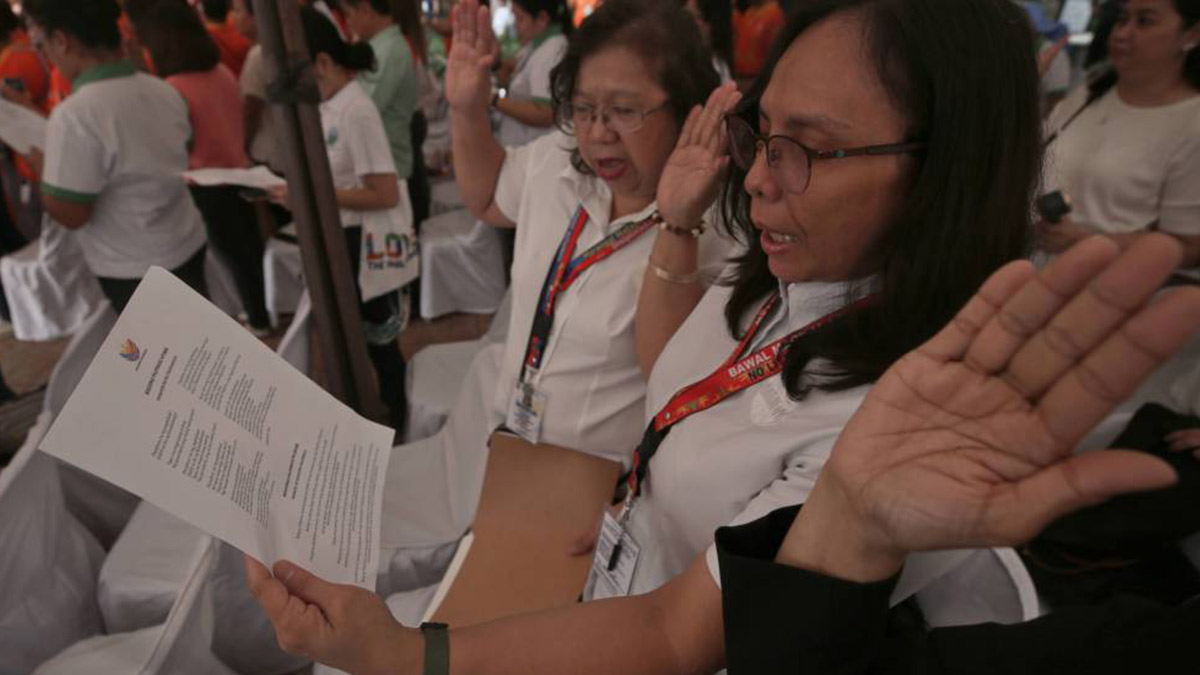Is it apt for group singing? ‘Bagong Pilipinas’ panned

VOW FOR A BETTER COUNTRY Government workers recite the “Bagong Pilipinas Pledge” after singing the national anthem during the opening ceremony of “Pampamahalaang Programa at Serbisyo,” a service caravan, at Rizal Park in Manila on Monday as part of the country’s 126th Independence Day celebration. —Richard A. Reyes
MANILA, Philippines — For a piece of music intended for community singing, it may still be far from being catchy, memorable, or inspiring.
The melody is “awful,” the lyrics “forgettable” and the voices “ill-blending,” said one activist-musician as he critiqued the “Bagong Pilipinas” hymn from a purely creative standpoint.
“That song is cheap (and) unplanned” and may not survive even the preliminary rounds of a songwriting contest, according to Edgie Francis Uyanguren, national coordinator for the Concerned Artists of the Philippines. “It wasn’t really thought out. It’s very clear in the lyrics.”
READ: Marcos’ order: Use Bagong Pilipinas hymn, pledge in flag ceremonies
For Uyanguren, it was “not a singable song” for big gatherings to begin with. “If you’re going to require it to be sung by students and teachers, the voices will really be different.”
Now uploaded on YouTube, the song—which runs for just over 3 minutes with electronic musical accompaniment, solo vocals, and choral arrangements—is now required by the Marcos administration to be part of flag ceremonies in public schools and government offices.
It immediately found critics, particularly victims of martial law atrocities during the regime of the President’s father and namesake, who dismissed it as self-serving and another attempt at revisionism to whitewash the memory of the dictatorship.
Parallels were also drawn between the new piece and the more upbeat “Bagong Lipunan” (New Society) march that served as the martial law anthem of the first Marcos presidency.
Malacañang on Sunday announced that under a memorandum circular signed by President Marcos, the new hymn and an accompanying pledge would now be part of flag rites across the bureaucracy “to further instill the principles of the Bagong Pilipinas brand of governance and leadership.” The Palace statement did not name who composed, wrote or sang the hymn.
More like pop
For Mony Romana, a music professor at the De La Salle-College of Saint Benilde and the Meridian International College, the song may be “too long” for its stated purpose.
“The writing itself is not fitting [for a hymn]. If the context here is to inspire or (make) a call to action, it did not hit any bars and it’s not inspiring enough if the objective was to inspire,” Romana told the Inquirer on Tuesday.
“If the goal was to inspire, the song falls short on that because the standards set in the song was too light compared to what was already set in the national anthem and even with the ‘Bagong Lipunan,’” he added.
“It sounds too much like a pop song that you would want to hear, but not something that you would order everyone to sing in the context of flag-raising rites.”
What’s ‘new’?
To be effective, a call-to-action hymn should be emotionally driven instead of just making promises, he added.
Choi Padilla, a music producer and jingle composer, said he found Bagong Pilipinas to be more of a campaign tune than a pledge of allegiance to the country.
“If this is how you wrote the song and you want it for [government employees and students] to sing it, it’s one-sided. And the title itself, ‘Bagong Pilipinas,’ (sounds) as if you are already gearing towards something like an agenda.” “Like, what’s ‘new’ at all? Is there something new? For it to be a hymn, it’s weird,” he added. “A hymn is supposed to show your love and allegiance to the country or that you are proud of it, and it should not show a facade that could divide the country.”